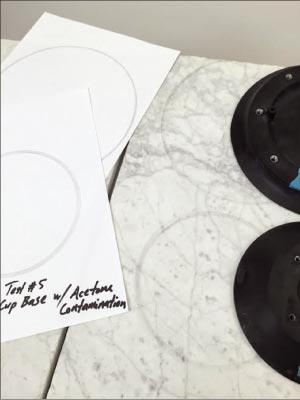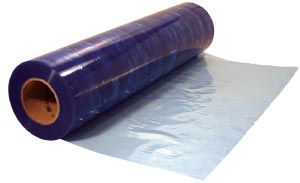Why Do Black Vacuum Cups Leave Marks?
Jessica Sherwood
Omni Cubed
Photos Courtesy Omni Cubed
 |
|
Occasionally, black vacuum cups leave acetone contamination stain, a problem that is more noticeable on light-color stone. The use of acetone as a stone cleaning solvent will accelerate the chemical breakdown of rubber vacuum cups. |
 |
|
Lifters, seam setting devices and hand vacuum cups all use black rubber cups, and have the potential to leave marks on surfaces. But don’t worry: a poultice can usually draw the stain out. |
 |
|
A 3 mil protective film like Americover is designed for clean release and easy removal without adhesive transfer, and can also be used to protect countertops in transport and on the jobsite. |
Rubber’s trademark black color comes from chemical additives used in the manufacturing process.
A common additive is carbon black, which helps strengthen rubber’s desirable properties, such as durability and UV resistance.
However, carbon black has the potential to leave marks on surfaces, as do several other components of the manufacturing process, such as plasticizers, processing oils, releasing agents, etc.
These substances can leach from the rubber over time and transfer onto contact surfaces—a big problem in the stone industry, notably when working with light-colored materials.
All vacuum cups made of black rubber have the potential to leave marks on surfaces. When a vacuum cup tool is used, the rubber is pressed tightly to another surface.
This pressure, and the rubber’s contact with the surface material, increases the potential for chemical leaching.
Aging and use of harsh cleaning solvents, such as acetone, also increase the potential for black rubber to leave stains and marks, because the rubber begins to chemically break-down with age or solvent exposure.
Prevention
To prevent stains on lighter materials, use a plastic protective film, like what is used to protect larger stone pieces during shipment and processing.
Simply apply smaller pieces of the protective film where black rubber vacuum cups will be used.
The film will adhere to the material very well, and the pressure from the vacuum cup on top will hold the film against the material even tighter.
It is recommended to test the film prior to use, to ensure it will not damage the material.
Removal
A poultice can be used to loosen rubber stains, and help draw them out of the material.
A poultice is a two-part paste consisting of a wicking chemical and an absorbent base.
There are some commercial poultices available such as Dr. Fred’s and StoneTech Professional Oil Stain Remover, by DuPont.
Also, many DIY poultice solutions can be found online, which are simple to make. The Marble Institute of America has an entire consumer page devoted to stain removal, including a sub-section on poultices.
Some stone fabricators have even suggested using carburetor cleaner to remove rubber stains on light-colored stone.
NOTE: With any chemical solution, be sure to test a piece of the same material first, to check for finish degradation or other undesirable effects before applying the chemical to the finished piece.